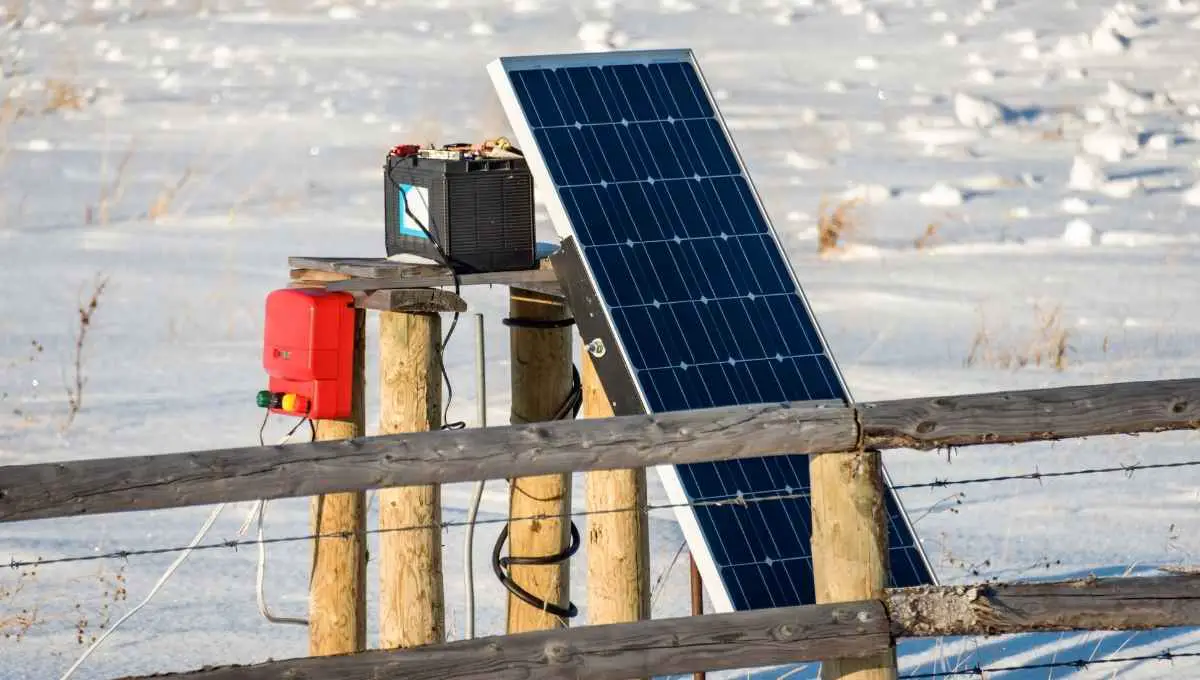Are Electric Fences AC or DC? (How to Decide Which is Best)

Choosing the right charger for your fence can be confusing for a first-time user considering all of the technical language and different components. Along with all of your other questions, you have probably asked yourself if electric fences are AC or DC?
Electric fences can be both alternate current (AC) and direct current (DC). It all depends on which charger you choose to supply your fence. A number of different factors will determine which type of charger suits your needs.
We will break down which type of charger is the best for your needs by outlining the advantages and disadvantages of both AC chargers and DC chargers so you can choose the best one for your fence.
This post contains affiliate links from Amazon and other stores. This means Yard Blogger may earn a commission if you make a purchase using any of our links. Please refer to our full affiliate disclosure policy for full details.
Here’s a Quick Pro Tip!
All things considered, an AC charger tends to suit the needs of most electric fence users thanks to its safe and powerful electrical output.
Here are some of our top recommendations from Amazon:
1. Zareba 25 Mile AC Charger – Great for medium-sized properties
2. Zareba 100 Mile AC Charger – Great for large properties
How Are Electric Fences Powered?
Electric fences are powered by a device called a charger, or sometimes called an energizer. This device plugs into a wall socket or is run by a battery and it manages the amperage and voltage coming out of the energy source.
The charger essentially regulates the amount of power coming out of your regular electrical circuit or battery so that it is suited for an electric fence.
Your charger will determine how strong of a shock your fence emits.
Do Electric Fences Use DC or AC?
Electric fences can use both direct current chargers (DC) and alternate current chargers (AC). The direct current charger is used when the fence cannot be plugged into a wall and runs off solar or battery power.
On the other hand, an AC charger can be used when you are able to plug it into a wall socket. Most electric fences use an AC charger because it is safer for the animals.
In fact, a DC charger is not UL certified, which means it does not meet safety and sustainability standards.
Is an Electric Fence AC or DC?
An electric can be either alternate current (AC) or direct current (DC). It all depends on what type of charger is being used. However, most electric fences use an AC charger because it is safer and uses less energy.
The charger you use will determine if your fence is AC or DC. An AC fence is more ideal because it delivers a quick pulsing shock to an animal instead of a continuous shock which can increase the chance of death.
You might also enjoy our post on Can an Electric Fence Start a Fire?
What Is an AC Charger?
An AC charger is the powerhouse of an electric fence. It delivers an electric current that alternates. Thus, the shock that is felt is a quick pulse that starts and stops very quickly. This pulse pushes the animal off the fence once it is shocked.
This is ideal because the shock will act in a way to only deter the animal, not to hurt it. A shock that is delivered non-stop can be hard to break free from and may cause harm to the animal, which is not the point of an electric fence.
What Is a Continuous Electric Fence Charger?
A continuous electric fence charger is also referred to as a direct current charger (DC). This type of charger release an electric current that flows continuously when it reaches something that is touching the fence.
It is different from an alternate current charger that delivers pulses of electricity because the current is moving back and forth very quickly. The continuous current moves in only one direction.
What Is a DC Charger?
A DC charger is a charger on an electric fence that produces a direct current (DC). When something touches the fence, it is shocked continuously until it is able to move away from the fence, if possible.
DC chargers have a reduced amperage and voltage so the shock isn’t as strong. DC chargers do not plug into a wall socket but instead work off a large battery, usually a car battery, or solar power.
Is It Better to Use an AC or DC Charger for an Electric Fence?
It is better to use an AC charger for your electric fence since they are safer for your animals, more effective, and use less energy. If you don’t have a place for an AC charger, you can always convert your DC charger into one.
The fact that an AC charger releases a pulsing shock makes it safer for animals to not receive a long, detrimental shock. The shock from an AC charger is rapid, usually lasting one second, and then stops quickly.
This gives the animal the chance to back off the fence whereas a DC charger emits a continuous shock that can be hard to break free from since it never stops.
You might also enjoy our post on If an Electric Fence Can Kill a Dog
What Are the Advantages of an AC Charger?
The advantages of an AC charger are plenty. Because the shock is a quick pulse, they are safer for animals because it allows the animal a chance to break free from the fence. The shock also pushes the animal off because of the pulse.
Other advantages of an AC charger include:
- Consumes less energy – more environmentally friendly
- Plugs directly into your electrical grid – more reliable
- Offers stronger power – more effective
- Supplies energy to a larger area
- Less expensive
What Are the Advantages of a DC Charger?
The main advantage of a DC charger is that it can be used in remote areas where connecting to an electrical grid is not possible. This is thanks to the fact that DC chargers are battery or solar-powered.
This feature is the main reason why people buy a DC charger- they are a good option for when you don’t have an electrical outlet or if you need to constantly move the fence.
Farmers who like to rotate where their livestock lives, for grazing purposes, will typically use a DC charger.
Can You Convert a DC Fence Charger to AC?
You can convert your DC fence charger to an AC fence charger with the help of a multi-power adapter. This will convert your DC charter that is run by a battery to 110-volt power.
An AC charger is more desirable because it is able to release more power. When you convert a DC charger, that has less energy, to an AC charger using a power adapter, you will be making your DC charger as strong as an AC charger.
How Does an Electric Fence Charger Work?
The electric fence charger is the powerhouse of the entire electric fence system. The charger produces high-voltage impulses that create a voltage between the conducting material and the ground.
When something touches the fence, they create a connection between the ground and the conducting material which completes the energy circuit.
A current then leaves the energizer, goes through the electric fence system until it reaches what is touching the fence, and delivers a quick, uncomfortable shock.
What’s the Strongest Electric Fence Charger?
The strongest electric fence charger is the Gallagher M10000i Fence Energizer. This charger has 100 joules of stored energy and can provide power to 125 miles/3,000 acres of electric fencing.
This charger, which is a 110v unit, is ideal for fences that cover a very large area of land.
You need a more powerful charger for larger areas because the power that is released needs to make it to every part of the fence with the same sustained power.
What Size Fence Charger Do I Need?
To choose the appropriate fence charger for your needs, you should assess four determining factors. You need to decide how long your fence will be, the number of wires it will have, your power source, and the type of animal you are trying to contain or exclude.
The length of your fence and the number of wires will determine the amount of power you need since the whole fence needs to be supplied evenly.
You will have to decide if you can plug in your charger to a wall outlet (AC) or if you will have the fence in an area that doesn’t have access to a wall outlet (DC or solar).
Additionally, you will have to decide which animals are the reason you are putting up the fence for. If it is a small animal, you will want a less powerful charger and vice versa.
You might also enjoy our post on If You Can Have an Electric Fence Around Your Property Legally
How Do I Choose an Electric Fence Charger?
To choose an electric fence charger, you first have to consider four different factors. The main one is your power source. If your charger will be able to plug into an outlet then you should use an AC charger.
If your charger will be further away from an electrical circuit then you will have to use a DC charger since these are battery or solar-powered.
You also have to consider what type of animal you’re containing or excluding. The smaller the animal the less power you will need. Along with the length of the fence and the number of wires.
Essentially, the larger the animal and the longer the fence, the more power you will need.
What Should I Look For in an Electric Fence Charger?
What you should look for in an electric charger depends on your needs. If your fence will be in a remote area or you will have to move it often, then you should opt for a DC charger since it is battery or solar-powered.
Other than that, you should consider the voltage and amperage of the fence as this will determine how strong of a shock the fence produces. For larger animals like cows and horses, you will need a more powerful fence.
Best Electric Fence Charger on Amazon
One of the best electric fence chargers on Amazon is the Zareba EAC25M-Z. This charger is AC-powered (alternate current) that supplies up to 25 miles of fence. It is perfect for containing many types of animals.
The Zareba 25 Mile AC Charger is perfect if you have a large property that contains a wide variety of animals, such as horses, cattle, and pigs, while also excluding predators and pets.
It is also UL approved meaning it meets standard safety and sustainability requirements.
Can My AC Electric Fence Controller Be Mounted Outside?
Since your AC electric fence controller plugs into an electrical socket, you have to mount it inside unless it is in a weatherproof shelter or enclosure outside. If you expose your AC controller to harsh weather it could malfunction or create a shock hazard.
You should always mount your AC controller in a weather-protected area, even if the unit’s outer case is described as weather sealed. It may not hold up in harsh, continuous weather.
Continue to check the area where your controller is mounted to ensure it is staying dry.
What Does Joules Mean on a Fence Charger?
The amount of joules on a fence charger indicates the amount of energy that is being sent through the fence. A fence charger will either indicate the number of joules as output joules or stored joules.
Output joules is the number of joules being sent through the fence and stored joules is the amount of energy in a charger’s capacitors.
To get an estimate of the number of output joules from a stored joules amount, multiply the stored joules by 0.7.
How Many Joules Should a Fence Charger Have?
An electric fence charger typically has 0.5 – 6 output joules. This means that when something touches the fence they will feel that specific number of joules. This is different than stored joules.
When deciding on the number of joules, look for the output joules number as this is the only number that matters. Stored joules misleads consumers who don’t understand the mechanism of joules.
How Many Joules Do You Need on an Electric Fence?
The number of joules you need depends on how long the fence is and how old it is. Typically, one joule per mile is recommended. The longer the fence, the higher the joule rating needs to be.
The joules are calculated by multiplying the volts with the amps and the time (volts x amps x on-time = joules). A charger that states on its label that it has 0.5 output joules means that it will emit 0.5 joules per shock.
How Many Joules Do I Need for a Deer Fence?
A deer requires between 0.5 – 1 output joules. Deers are very strong and large so it’s likely that this won’t even be enough for them. However, you shouldn’t go higher than this as it may harm the deer.
You can find many fence chargers that have 1 output joule that is suitable for deers. But, keep in mind that electric fences can sometimes be useless for deer since they are very strong and they can also jump very high.
You might also enjoy our post on If Plants Can Touch an Electric Fence
How Many Amps Should an Electric Fence Have?
Electric fences typically have 120 milliamps. This is a safe amount of amps that will only deter animals and not hurt them.
AC chargers are able to put out 120 milliamps but DC chargers are not. Since DC chargers release a continuous current of electricity, they have to release a lower amp in order not to harm anything.
What Is the Voltage of an Electric Fence?
The voltage of an electric fence refers to the pressure of the electric current that is moving through the fence. When you have a longer fence, you need more voltage so that the electricity is able to spread a greater distance.
The voltage of the electric fence also depends on what animal you are trying to contain or exclude. If you have a larger animal, you will need more volts since it will make the shock stronger.
How Many Volts Should a Fence Charger Put Out?
The number of volts a fence charger puts out depends on the type of animal you are trying to contain or exclude. As a basis point, cows require 4,000 – 5,000 volts.
On the lower end, if you are trying to contain a dog, then you need a fence with around 3,000 volts. For animals with thick coats, such as goats, you need around 7,000 – 9,000 volts.
Related Questions
Do Solar-Powered Electric Fences Work At Night?
Solar-powered electric fences will work at night because they have absorbed enough energy during the day to make it through the night, as long as there is enough sun during the day.
If you live in a sunny area, then a solar-powered charger is a good option since it will be able to work all day and all night. However, if you live in a cloudy, dreary area, then you may run into some trouble.
You might also enjoy our post on Are Outdoor Outlets Safe in Rain?
Are Electric Fences Expensive to Run?
To the surprise of many, electric fences that use an AC charger are not expensive to run. It has been noted that they only affect your electricity bill by less than one dollar a month.
This is because an electric fence with an AC charger basically runs on passive electricity since it is plugged into your electrical circuit. On average, an AC charger uses 33 watts per day.
The average cost of a kilowatt-hour is 12 cents so the cost of running an electric fence is three cents for the entire month.
Final Thoughts
The type of electric fence charger all depends on your specific needs. However, in the end, if you can use an AC charger it will be the most beneficial for the environment, your bank account, and the health of your animals.
Keep in mind that if you have to use a DC charger because of a lack of electrical outlets, you can always convert it to an AC charger with a power adapter.








